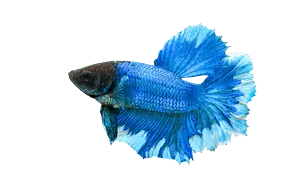It’s tricky finding a good tank mate to liven up your betta’s aquarium because betta fish are such characters!
But snails are generally peaceful creatures who help maintain a clean environment.
This is why many fish keepers add snails to their aquariums, especially if they have betta fish.
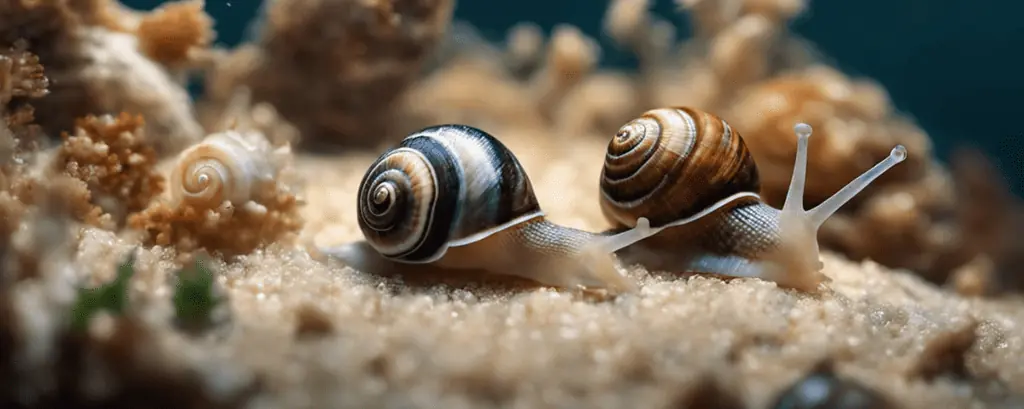
Table of Contents
Are Snails Required for Betta Fish Tanks?

Betta fish do very well on their own and do not require any tank mate.
Snails are not necessary, just a beneficial addition to the aquarium.
If you choose to keep your betta alone, you need to be ready to do a little bit of extra tank maintenance.
This means getting an algae scrubber, first and foremost.
Algae contributes to health issues in betta fish, which is why we clean it up before it gets out of control.
Snails are algae-eaters, so they take care of this job for you.
They also take care of things like food waste.
Without snails, you must be more on top of cleaning waste.
Scooping uneaten food out of the tank after meals is another task you must take care of when you don’t have snails.
Many betta fish owners don’t like caring for snails.
It is entirely doable to keep a betta with no tank mates!
But they do make cleaning less of an issue.
Our Individual Snail Guides
Benefits of Keeping Snails with a Betta
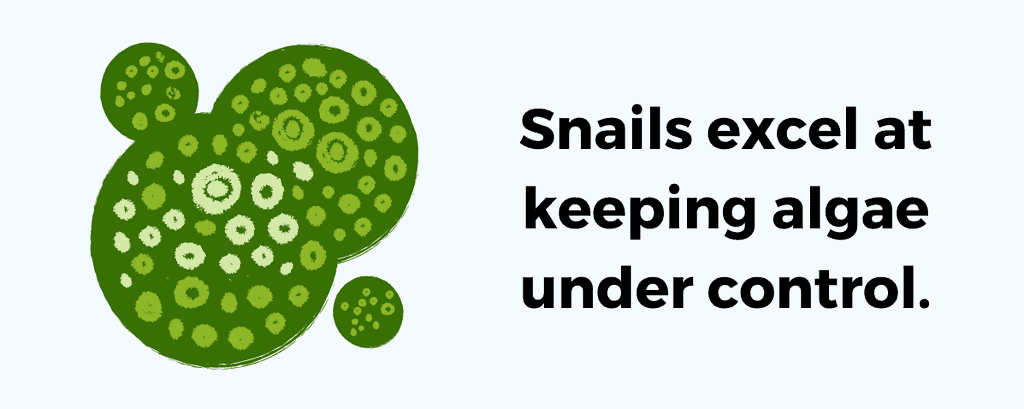
Every snail is unique, so the exact benefits they bring to the table differ.
But here are some common reasons people love snails for the betta tank:
- Algae eaters
- Waste control
- Enrichment
- Peaceful
- Food supplement
- Aerate substrate
Algae Eaters
Snails are famous algae eaters. They excel at keeping algae under control in the tank.
This is an important job because algae is detrimental to your betta’s health.
While some snails help with algae but don’t eat it all, others scrub the tank clean of the stuff!
Some fish keepers say their snails keep the tank clean enough they never have to break out their algae scrubber.
Get some snails if you’re not a big fan of keeping with this tedious part of your fish’s care routine.
Of course, there is a lot you still need to do to maintain the ecosystem for a healthy fish.
But snails are great helpers, especially with algae.
Remember, though, different types of snails can eat more or less algae.
Waste Control

There are so many things in your betta tank producing waste!
Decaying plants, uneaten fish food, the animals themselves, and other sources of waste make it challenging to maintain a clean tank.
Fortunately, snails are great at dealing with a lot of these things.
They happily eat leftover food your fish didn’t finish.
Uneaten fish flakes or pellets are a significant source of food for your snails.
The dead plant matter is another essential food source for them.
Snails feed on organic debris, food waste, and even dead fish or shrimp in the tank.
They look out for your tank in many ways you may not even notice.
Remember, you are still responsible for keeping up with your betta’s care routine.
Partial water changes need to remain consistent. Keep testing the water for ammonia spikes.
Being animals themselves, snails produce waste as well as clean it up.
They are not a means to start neglecting your fish’s environment.
They’re just wonderful helpers and make an adorable little clean-up crew!
Enrichment

Snails come in various colors and are a popular choice to liven up the tank.
I guess this isn’t the most crucial aspect of life as a snail owner. But it is certainly a nice bonus!
When you have a bigger tank size and the aquarium starts to feel empty, giving your betta some shrimp or snail friends is a game changer!
Even just a few snails make the tank look livelier and provide enrichment for you and your betta.
You may catch your betta mouthing at the snails or nipping at them. If your snail isn’t freaked out, don’t worry!
This is likely your betta’s way of exploring.
Many common snail species are too big for your betta to eat anyway.
Peaceful

Snails are some of the sweetest little creatures you’ll ever add to your fish tank.
They don’t disrupt the ecosystem, and it is exceedingly rare for them to behave aggressively.
Where shrimp and betta fish are tough to keep together peacefully, it’s very natural for snails.
Aquarium owners rarely express problems between their snails and betta fish.
If anything, it is usually an aggressive betta who did not want a tank mate!
Many types of snails are so unimposing that your betta won’t even think to bother it.
Food Supplement
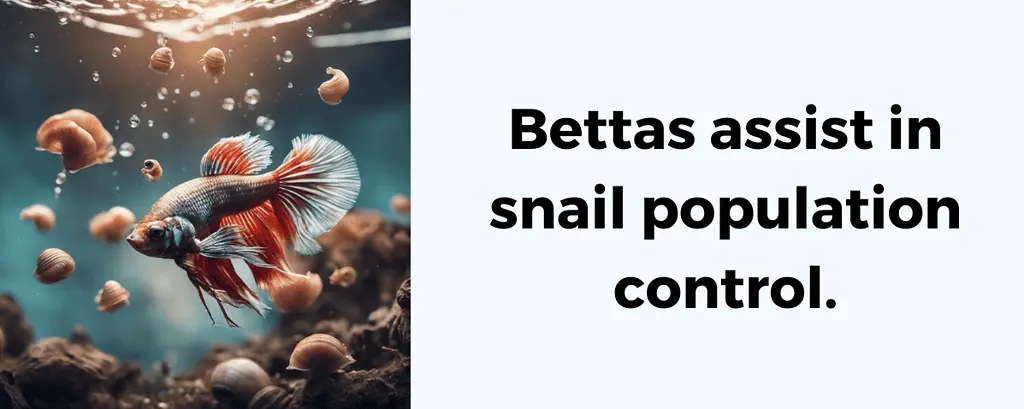
Your betta can eat small snails if they get hungry.
Ideally, they only do this when the snail population starts to boom. You don’t want them eating every snail you own.
But this is helpful for two reasons.
First, they may reproduce very quickly depending on the type of snail you get.
In this case, it’s nice for your betta to help with population control.
Second, snails are a nutritious snack for your betta.
While they aren’t one of the recommended snacks aquarists give their betta fish, snails are perfectly safe for your betta to eat.
Aerate Substrate

Aside from keeping the tank clean, snails are great at aerating the substrate.
Aeration is beneficial to your betta fish for a few reasons. Mainly, though, it raises oxygen levels in the water.
Many people struggle with keeping oxygen levels up in their betta tank, and snails are great helpers with this.
When you want to aerate the substrate manually, you must install an air stone or other aerator.
Some types of snails do this completely naturally!
The more they like burrowing into the substrate, the better the snail will be at aerating.
Risks of Keeping Snails with a Betta

Snails are an essential part of your tank’s ecosystem. But caring for snails isn’t all sunshine and roses.
Here are some common concerns people have about keeping snails with a betta:
- Aggressive betta
- Different water parameters
- Waste production
- Space requirements
- Disease
- Getting stuck
- Rapid reproduction
Aggressive Betta
If your betta is incredibly territorial, it may not tolerate snails or other tank mates.
Snails are one of the least imposing forms of aquatic life, which is why they usually do so well in betta tanks.
But this does not mean every betta will be comfortable living with snails.
Now, the risk of your betta eating a snail is pretty low. Their shells are a bit of an obstacle!
The smaller the snail, the more likely your betta will eat them anyway.
But an angry betta may start nipping and stressing the snails out.
The aggression levels of your betta determine whether snails can live in the tank at all!
Different Water Requirements

There are certain fish we never house together, which has nothing to do with temperament.
Instead, some aquatic lifeforms have different environmental needs.
Make sure any snails in your tank are safe in the pH and temperature your betta needs.
Water parameters are essential to the health of both snails and betta fish.
Don’t cut corners on this one.
Waste Production

Waste production is the biggest reason some people don’t like caring for snails.
While they help out a lot with maintaining a clean tank, they also produce waste.
This means ammonia levels may rise if you don’t keep up with water changes.
As you may already know, excess ammonia in the tank leads to all sorts of health issues for betta fish.
It is also highly harmful to snails.
Of course, some snails are worse at waste production than others.
Depending on how much ammonia your snails produce in the water, you may need to make water changes more frequent.
Space Requirements

Finally, all aquatic life needs a certain amount of space to live.
Betta fish like having at least 5 gallons of water to swim around.
To make up for the added waste production and allow your pets to be comfortable, you need more space to accommodate the snails.
This is extremely important because crowding is so bad for aquatic life!
Betta fish are notoriously territorial, which is why they become more aggressive when their space is invaded.
Even if your betta is more of a lover than a fighter, they will become stressed when the tank gets crowded.
Stress is a precursor to all kinds of health complications in betta fish!
Disease

One common concern people have when adding any new life to their aquarium is disease.
When you feed your betta black worms or add another fish, you face the same possibility.
By exercising a bit of care when you buy the snails, you avoid this problem.
Always buy from a reputable seller, and ask lots of questions!
Once you add the snails to the tank, keep an eye on your betta’s health.
Getting Stuck

One of the struggles of being a snail is getting stuck to the aquarium glass.
Hey, if your feet were sticky enough to let you walk on walls, you would get stuck too!
Be prepared to gently scrape a snail off the glass and possibly clean up afterward.
They won’t be able to keep eating algae and helping out with ecosystem care if they’re trapped.
Rapid Reproduction

Snails are incredibly fast when it comes to reproducing. Sometimes it seems like they’re multiplying overnight.
Betta fish with enough of an aggressive streak will eat some of the babies. They’re small enough and not so well protected as adult snails.
Despite your betta’s help, controlling the snail population isn’t always easy.
But snails aren’t the most resilient, nor do they have the longest life span.
They reproduce quickly but die before too long. This is another thing to watch out for.
You must keep an eye out for new and dead snails.
Dead snails need to be removed from the tank so as not to spike ammonia levels.
How to Feed Snails in a Betta Tank

Snails are scavengers, which makes them very low-maintenance pets.
While a balanced diet must have plenty of variety, this isn’t hard to provide for snails.
Here’s a list of foods they like:
- Algae
- Blanched vegetables
- Snail pellets
- Fruit
- Frozen foods
Algae
Algae is high in fiber and nutrients, which makes it nice and healthy for your snails.
It’s also easily accessible for them because it floats.
Snails will devour any algae they find in the tank. But they need more than algae to survive and feel good.
Blanched Vegetables

Don’t feed just anything to your snails. There are only a few vegetables they can have.
A couple of safe veggies include carrots and peas.
But remember, anything you drop in the tank for your snails is also available to your betta.
Double-check that the vegetables you offer are safe for snails and betta fish.
Snail Pellets

Snail food sold commercially often comes in the form of algae pellets.
These pellets are great for ensuring your snail gets balanced nutrition.
Calcium-rich food is essential for snails but not so much for betta fish, so pellets are an excellent way to supplement calcium.
Your betta fish are unlikely to bother them at all because they are not made of shrimp or other betta foods.
If you invest in some pellets for your snails, keep an eye out for signs of overeating.
Often snails do just fine on leftover food from your betta.
One sign of overfeeding is a sudden boom in the snail population of your tank.
Fruit

The best fruits for your snails have high fiber and water content.
Even healthy fruits must be fed sparingly. This isn’t an everyday meal for your snails.
Your betta fish may decide to have a taste, and fruits are not the best for their stomachs.
You also need to remove any uneaten fruit as quickly as possible.
It will rot if left for too long in the tank. This pollutes the tank water and may make your snails and betta fish sick.
This is more of an additional food to use once in a while than something to feed regularly.
Frozen Foods

Many of the frozen treats your betta fish loves are also great for your snails.
Bloodworms, brine shrimp, and daphnia are high-protein snacks to improve your pets’ health.
You don’t necessarily need to add a lot of extra snacks into the tank, though.
Anything your betta doesn’t finish will end up as snail food anyway!
Check out our complete list of the best treats for betta fish to get more ideas.
Best Snails for a Betta Fish Tank
Different types of snails offer different benefits to your betta tank, so choose wisely based on your specific needs.
Remember, the pH and temperature of your betta’s water must be set so the snails and betta will be safe.
Here is our list of the best snails for your betta’s aquarium:
1. Nerite Snails
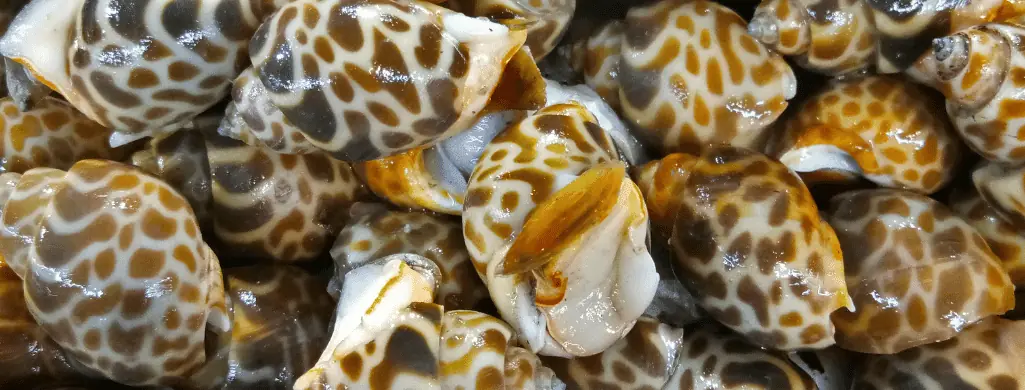
- Size: 0.25-0.5″ inches (small)
- pH: 7.5
- Temperature: 72-78° degrees Fahrenheit (22-26° C)
Nerite snails do not reproduce in freshwater. This means you won’t need to worry about population spikes.
They’re low-maintenance, hardy algae eaters, but they are unlikely to bother your aquarium plants.
Unfortunately, this is a snail you might find escaping the tank. You need a lid to contain them.
They also struggle in tanks with too high of a temperature. To keep them with a betta, you must keep the temperature at 78° degrees Fahrenheit (27° C).
2. Mystery Snails
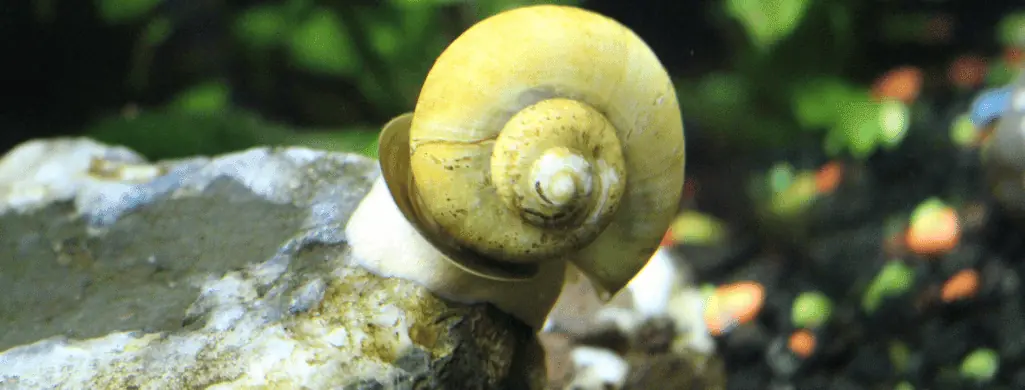
- Size: 2″ inches (bigger than Nerites)
- pH: 7.0-7.5
- Temperature: 68-82° degrees Fahrenheit (20-27° C)
One bonus of keeping Mysteries is they have the same light and dark cycle as betta fish.
They don’t reproduce in freshwater, either. So, just like Nerites, they won’t multiply right before your eyes.
These guys are reliable algae eaters as well!
What many aquarium hobbyists love about Mystery snails is their beautiful range of shell colors.
They liven up any tank they’re added to!
3. Assassin Snails
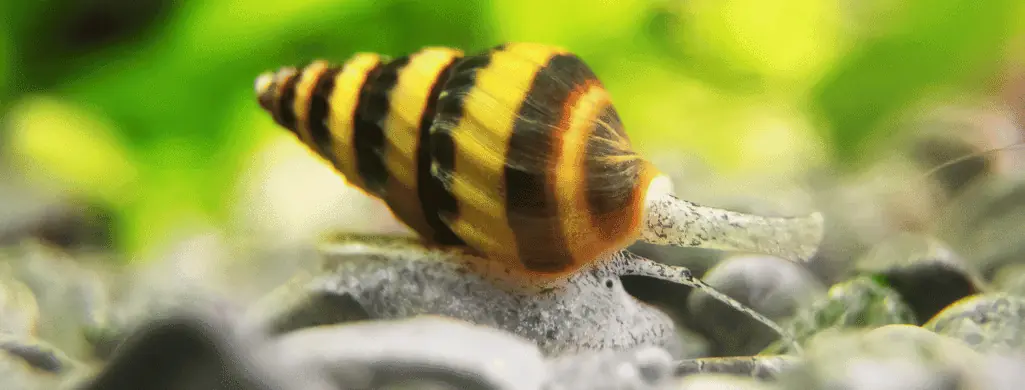
- Size: 3″ inches (large)
- pH: 7-8
- Temperature: 75-80° degrees Fahrenheit (24-27° C)
These guys are big and need a larger tank to live with a betta.
They’re also carnivorous, which means they help keep their population under control.
This type of snail may not be suitable for you if you have a small or especially chill betta fish.
Assassin snails have been known to eat small fish and shrimp they are housed with.
If your betta is tough and knows how to defend themself, great. Otherwise, choose a more peaceful snail.
4. Japanese Trapdoor Snails
- Size: 2″ inches
- pH: 6.8-8.0
- Temperature: 68-85° degrees Fahrenheit (20-29° C)
Japanese Trapdoor snails are great at eating algae, like Nerite or Mystery snails.
But these guys are also good at aerating your aquarium substrate. This means less algae will be produced in the first place.
You may need to buy algae pellets for them. But the oxygen levels in your tank will be great!
On the other hand, these snails don’t require as much food as different varieties to do well.
Depending on how much food waste and dead plant matter your tank has, they may not need those pellets.
5. Malaysian Trumpet Snails (AKA Turret Snails)
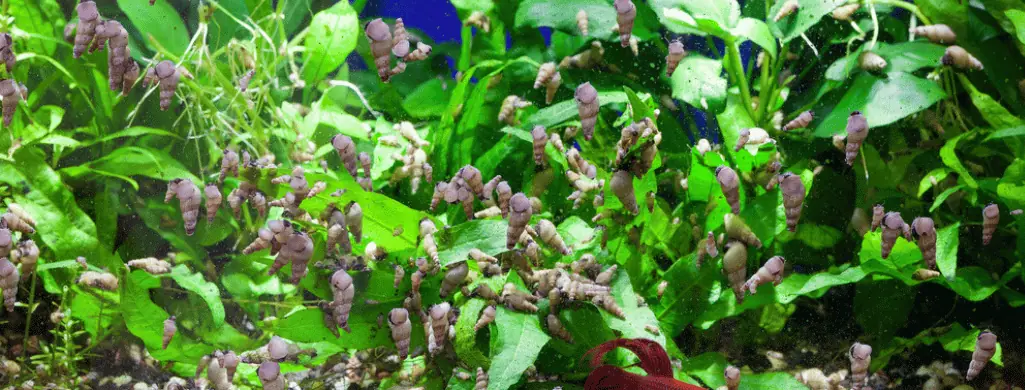
- Size: 1.5″ inches
- pH: 7.0-7.5
- Temperature: 70-78° degrees Fahrenheit (22-26° C)
The defining trait of the Malaysian Trumpet snail is its ability to aerate tank substrate.
They love burrowing in the substrate and hiding away in there. You might not see them for pockets of time, but they are still hard at work in your tank.
Turret snails are excellent scavengers and very effective at cleaning up food waste.
The only downside with these guys is how much they like live plants.
If you have live plants in your aquarium, Turret snails are likely to nibble on them.
6. Apple Snail
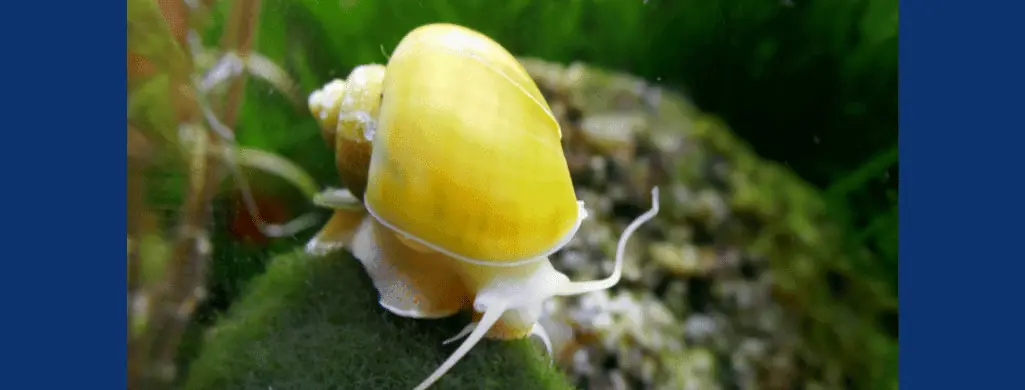
- Size: 1-2″ inches
- pH: 6.5-8.0
- Temperature: 70-80° degrees Fahrenheit (22-27° C)
An important note on Apple Snails is higher temperatures increase their rates of reproduction.
Betta fish need a tank around 78-80° degrees Fahrenheit (27° C), which means Apple snails multiply fast in a betta tank.
Apple snails are not among the more popular snail species because of how much they reproduce.
Unless your betta has an appetite for snails, the population will get out of control quickly.
Apple snails enjoy eating live plants as well.
If you keep live plants in the aquarium, you’re better off with Nerite, Mystery, or Japanese Trapdoor snails.
7. Ramshorn Snails
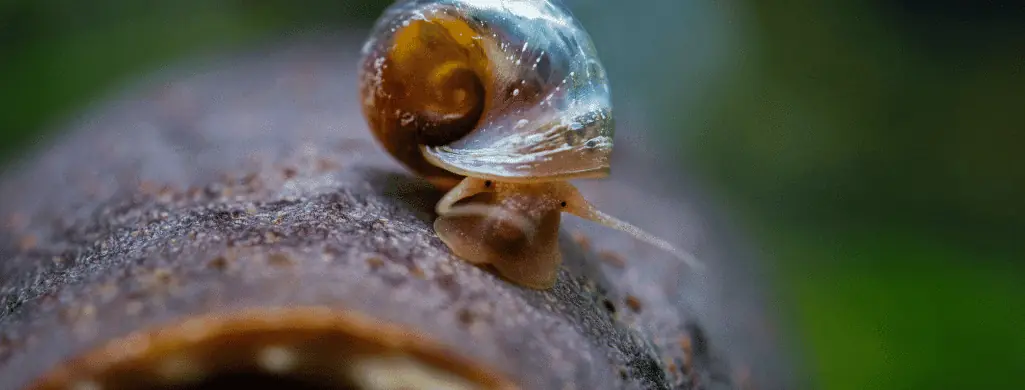
- Size: 1-1.5″ inches
- pH: 7.0-7.5
- Temperature: 70-78° degrees Fahrenheit (22-26° C)
Ramshorn snails are incredible algae eaters and very hardy creatures.
However, they are famous for introducing diseases to aquariums with other aquatic life.
Unless you know a reliable seller who has offered you Ramshorn snails, it is safer to go with another variety.
If one shows up unexpectedly or you decide to buy one anyway, keep an eye out for signs of sickness.
8. Pond Snails

- Size: 1″ inch
- pH: 7.5
- Temperature: 70-78° degrees Fahrenheit (22-26° C)
Pond snails are common but usually not expected.
These guys like to stow away on live aquatic plants and make themselves at home in your tank.
Much like the Apple Snail, they reproduce extremely quickly! This makes them a bit of a nuisance if you don’t catch the eggs in time.
However, if you see the eggs, they are easy to remove.
Furthermore, Pond snails are unlikely to eat your live plants. But they are easily overfed simply with food leftovers from your fish.
Overfeeding encourages population outbreaks, which makes the Pond snail challenging to care for.
FAQs for Keeping Snails

Can I keep just one snail in my betta fish tank?
If you want to add one snail to your betta’s tank, go for it!
Snails are not the most social creatures, so it’s not inhumane to keep just one or two. This is more humane if your betta’s tank is only 5 gallons or slightly smaller. Snails need space, and so do betta fish!
Remember that your snail may not be as helpful in tank maintenance if you only have one. However, they will enjoy snacking on algae produced in the tank without eating as many of your live plants.
They also won’t produce as much waste as an entire group of snails would.
If you add just one snail, prioritize based on their skill set.
Are you looking for a good algae eater? Get a Mystery snail or a Nerite.
Want something pretty? Mystery snail all the way! Prefer a snail who can aerate the substrate in your tank? Opt for a Turret snail instead.
Does my snail need a special filter?
Your snail will likely do just fine with the filter you already have.
Betta fish do well with sponge filters and other low-power filters. They are not the best swimmers and therefore hate a strong current.
Your snails have the same needs! Snails don’t swim like betta fish, but a strong current would easily move them. If you have a sponge filter or another low-pressure filter in your betta fish tank, you don’t need to make any changes.
Can Snails Climb Out Of My Fish Tank?
Certain types of snails are more adept than others at escaping the fish tank.
Nerite snails and Mystery snails are the two most notorious varieties for this! Keep the little escape artists in by putting a lid on your tank.
If you want your snails to be able to reproduce, you need the water level to be a couple of inches below the lid. Your betta fish has similar requirements anyway, though. Betta fish are good jumpers and sometimes launch themselves right out of the tank!
For this reason, you need to use a covered tank and ensure the water level is not too high. Snails are tricky and sometimes can escape even a covered tank by some miracle.
Don’t worry too much about it, though. Some people have no trouble with this, while others struggle a lot. If you want to entice your snails to stay in the tank, make sure it’s decked out!
Get plenty of live plants, feed them algae pellets, and take good care of their environment. By keeping up with your care routine and putting a lid on the tank, you lower the risk of your snails climbing out of the tank.
Snails Galore
Snails are some of the most reliable tank mates for betta fish.
Not only do they help maintain the ecosystem, but they don’t usually bother the betta at all.
The essential part of moving in one or more snails is ensuring correct water parameters.
Most snails tolerate a wide range of conditions. But don’t go too far outside their preferred temperature or pH.
If you’d like to see more algae-eating tank mates for your betta, read our article on the best algae-eaters!

